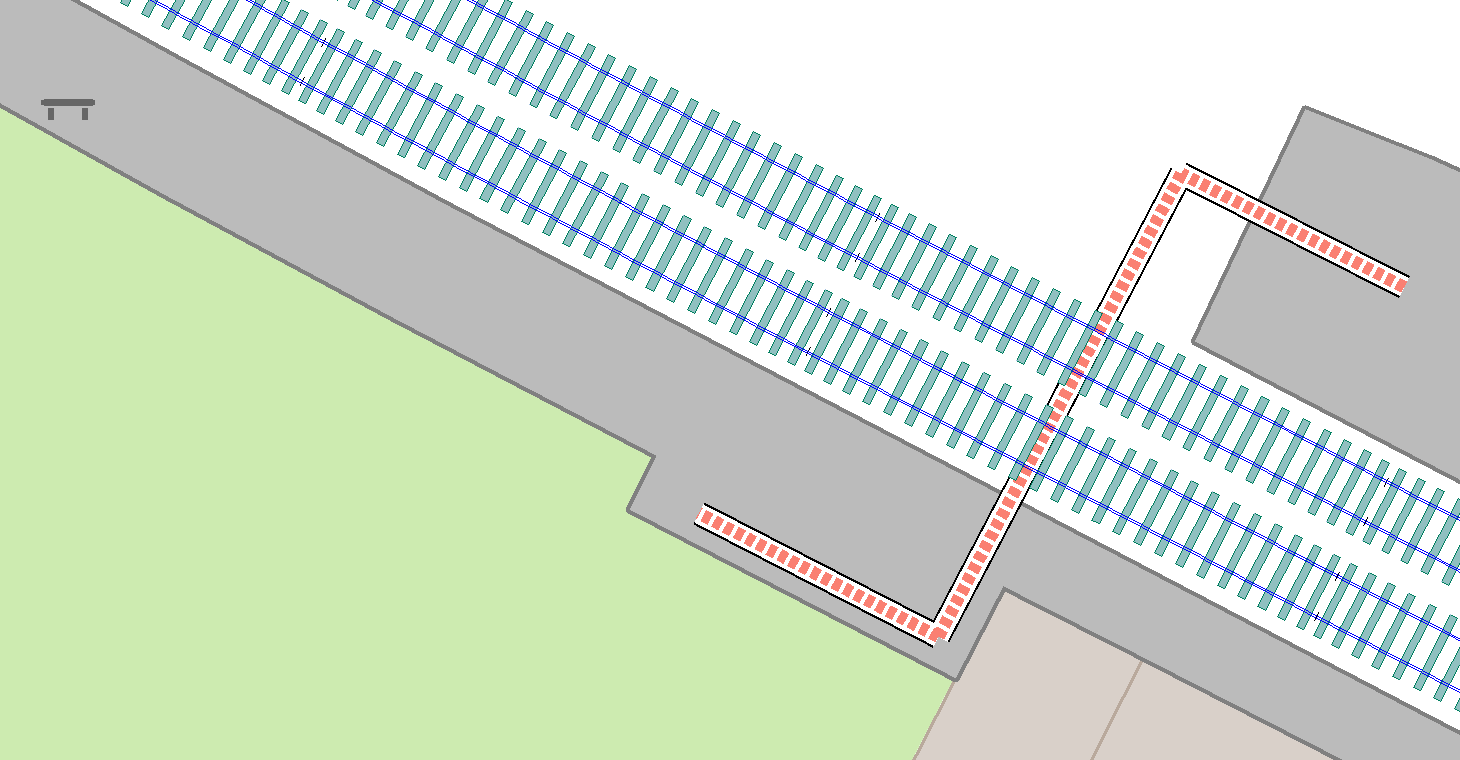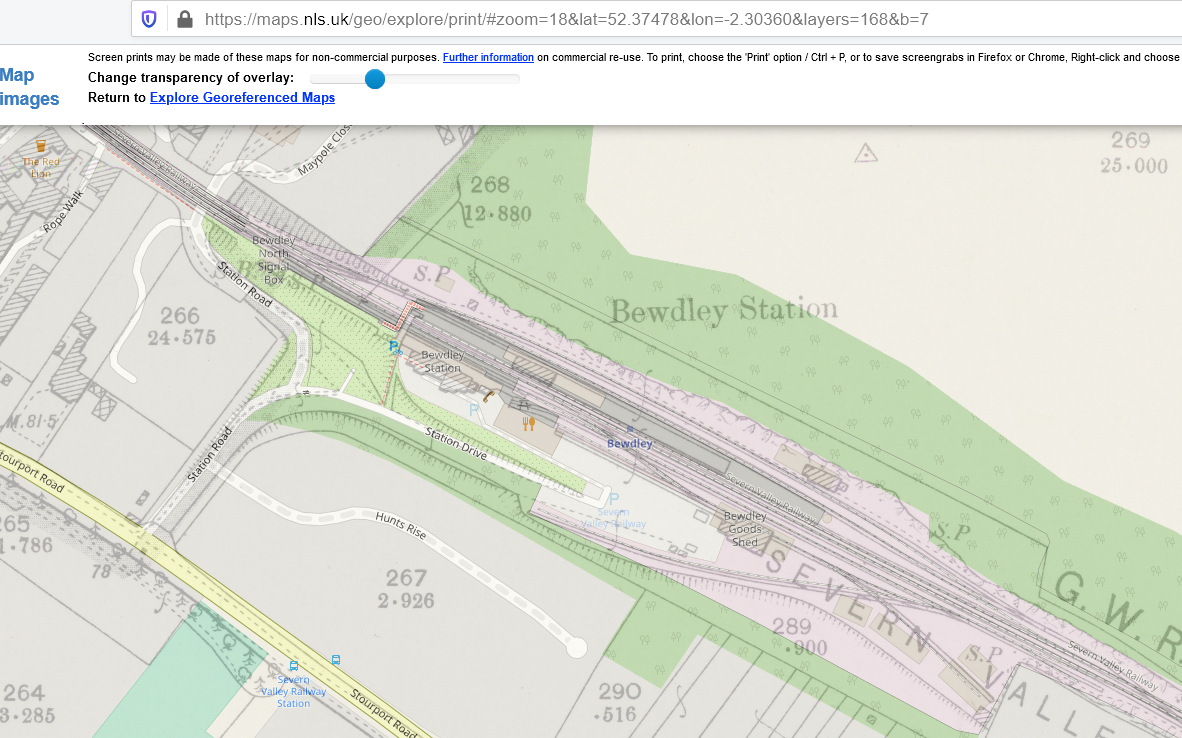Templot Club Archive 2007-2020
|
|||
| author | remove search highlighting | ||
|---|---|---|---|
|
posted: 25 Jul 2020 01:38 from: Martin Wynne
click the date to link to this post click member name to view archived images |
Here's a screenshot: 2_281457_560000000.png  And here's a map: http://www.openstreetmap.org/#map=19/52.37596/-2.30721&layers=N As you can see, it has been zoomed in, the poor symbolic track representation has been removed, and proper Templot tracks drawn in its place. Somewhere here is the germ of an idea, but I can't quite put my finger on it. Imagine capturing a background map in the same way as the NLS historic maps. But from the Templot server. And it contains not fuzzy track lines, but Templot track templates, ready to use or modify. Would that be useful? And how many Templot volunteers, working for how many years, would it take to create a reasonable coverage of the UK? But if restricted to a few selected locations, it might be possible at least to make a start? Or it might be a very silly idea. Martin. |
||
|
posted: 25 Jul 2020 02:29 from: Rob Manchester
click the date to link to this post click member name to view archived images |
Hi Martin, Interesting idea. Are you thinking it would be possible ( given time ) to produce Templot box files from the details of tracks contained in OSM ? Are the tracks on OSM not just symbolic rather than actual layouts ? Take this pic as an example: Glasgow Central approaches ..and the OSM view here Your GWR station example is rather more likely to appeal as a model and would be much easier to do but how many would want it with a 2020 track layout ( assuming it isn't as it was back in 1930 )? I am sure many would have planned layouts around the OPC Clark/Potts Great Western layout plan books but presumably it wouldn't be possible to use these as a source for Templot files to be held in a downloadable library. Like I say, nice idea. Just not sure the usage would justify the effort. Rob |
||
|
posted: 25 Jul 2020 04:55 from: Andrew Barrowman
click the date to link to this post click member name to view archived images |
Hi Martin, An interesting idea I think it might be possible to create an application that did that automatically on a "best fit" basis. Sounds like a great project for some of your local Computer Science undergrads. The profs at the CS departments are always looking for interesting challenges as are grads who are trying to get a PhD. I'm more than a bit out of touch these days but I can probably find a contact if you are interested. Cheers, Andy |
||
|
posted: 25 Jul 2020 09:32 from: Martin Wynne
click the date to link to this post click member name to view archived images |
Rob Manchester wrote: Are you thinking it would be possible ( given time ) to produce Templot box files from the details of tracks contained in OSM ? Are the tracks on OSM not just symbolic rather than actual layouts ?Hi Rob, Andy, Thanks for your thoughts. No, I wasn't thinking of using the symbolic tracks in OSM at all. They would be deleted entirely. The NLS historic maps (and most slippy maps, including the OSM standard map) use raster (bitmap) tiles, on which it is impractical to think of editing-out or replacing any detail. And in any event there would usually be copyright issues with such re-use. But in OSM the underlying data is freely available for anyone to use for anything. Any element can be modified or replaced at will (but not necessarily uploaded back to the OSM map if it is not an accurate representation of what's on the ground now). Here for example is that area of Bewdley in one of the OSM editors, with the OSM raster tiles as the underlying image: 2_250356_110000000.png  Using the editors the symbolic tracks can be removed and replaced with something else. A monorail? A canal? An airport runway? Or maybe Templot track templates representing the historic tracks, or the modern tracks, or a fictional layout idea, such as a narrow-gauge line. And maybe Templot could do that replacing itself? In the above editor the finished design, rather than being uploaded to OSM, can be saved locally as an .osm (XML-based) file. And then using one of several open-source tile generators used to create a series of tiles on the Templot server as a "Templot map" entirely separate from OSM. In a conventional slippy map the tiles are bitmaps, but I'm thinking the Templot tiles could be EMF metafiles, which could be zoomed, printed, and used as construction templates in the usual way. Possibly we don't need any of the original OSM map detail at all, and can simply use the OSM functions to provide the geo-referencing and conversions. On the NLS historic maps it is possible to use OSM as the cross-fade background layer: 2_250417_280000000.png  see: http://maps.nls.uk/geo/explore/print/#zoom=18&lat=52.37478&lon=-2.30360&layers=168&b=7 which could be used now in the current maps function in Templot to create the templates. (notice the mismatch in the OS historic mapping from the OSM data, derived from modern aerial imagery) cheers, Martin. |
||
|
posted: 26 Jul 2020 00:18 from: ikcdab
click the date to link to this post click member name to view archived images |
Martin Wynne wrote: Rob Manchester wrote:ref "(notice the mismatch in the OS historic mapping from the OSM data, derived from modern aerial imagery)"Are you thinking it would be possible ( given time ) to produce Templot box files from the details of tracks contained in OSM ? Are the tracks on OSM not just symbolic rather than actual layouts ?Hi Rob, Andy, i worked in mapping for 35 years, using both old data and more modern. What i unfailingly found was that the "historic" surveyors did know where they were and their positioning was almost always spot on. Sometimes their data is a little sparse, but what is there is normally positioned correctly. The problem with using modern aerial imagery is that issues such as lens or atmospheric distortions, parallax and shadowing can make positioning more problematic. especially when used by "amateurs" to update OSM. There is every chance in your example that the historic mapping is right and that the data derived from imagery is not quite so good. To be honest, thats why people like the OS or the UKHO have very expensive machines to plot details from imagery, |
||
|
posted: 28 Aug 2020 18:28 from: DerekStuart
click the date to link to this post click member name to view archived images |
Hello Martin A sound idea. Are you suggesting recording the trackwork as it is currently, or can any era be included, giving the viewer the choice which era s/he wants to look at? Given the amount of 'real location' modellers, there's probably a good start already (albeit some of those 'real location' modellers will take the awkward habit of compressing things.) For example I have/ had/ can again Whitby pre 1960s, Edinburgh Waverley pre 1960s, pre 1980s, Battersby circa 1950, Wolverton Works, and part of Darlington Top Bank (pre 1960s). But they were all sitting on top of NLS (OS?) maps and may be slightly different scales to your Open Source (as per my other post). Nice idea. I find replicating locations in Templot to be as enjoyable as building anything else for real. Derek |
||
|
posted: 28 Aug 2020 19:15 from: Martin Wynne
click the date to link to this post click member name to view archived images |
DerekStuart wrote: A sound idea. Are you suggesting recording the trackwork as it is currently, or can any era be included, giving the viewer the choice which era s/he wants to look at?Hi Derek, What I was Of what era, or gauge, or whatever, would be a matter for whoever was compiling that bit of the map. There might be both historic and modern layers for some popular locations, or a what-if guided busway instead. As a drop-down list of available map layers. The reason for using OpenStreetMap as the basis is that it provides a copyright-free means of geo-referencing, so that the switch toe is the correct distance from the bridge and from the church doorway, and so that adjacent map tiles, compiled by different people or at different times, align seamlessly as you scroll across the map. Clearly doing the whole country is a silly pipe-dream, but it might be possible to start with a single location, and experiment with getting the tiles on the Templot server in the format used by slippy maps. As an overlay on OpenStreetMap, with the existing OpenStreetMap railway lines removed. The tiles on most slippy maps are PNG bitmap images, usually 200x200 or 256x256 pixels each. For this idea to work they would need to be EMF or SVG files, so that they could be zoomed and printed as usable track templates. cheers, Martin. |
||
|
posted: 28 Aug 2020 20:32 from: DerekStuart
click the date to link to this post click member name to view archived images |
Thanks Martin I don't think it's a bad idea at all. It's one of those things that could evolve over years rather than needing X added by AA/BB/20CC. I would imagine that the most likely people to view such features are rail/ model enthusiasts rather than 'normal' people and as such I would guess most people will gravitate to the usual sorts of places. I'm just getting back to using Templot after months of 'not using Templot' and cursing my old grey brain cells at the moment... Please don't even ask how much of Lazarus I can remember- but suffice to say you were right "keep at it regularly or you'll forget." |
||
| Please read this important note about copyright: Unless stated otherwise, all the files submitted to this web site are copyright and the property of the respective contributor. You are welcome to use them for your own personal non-commercial purposes, and in your messages on this web site. If you want to publish any of this material elsewhere or use it commercially, you must first obtain the owner's permission to do so. |